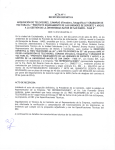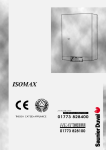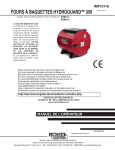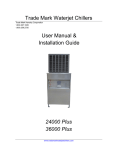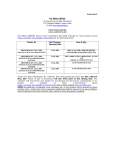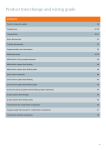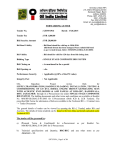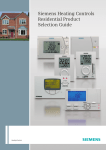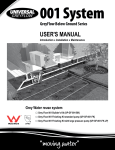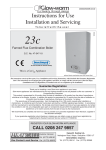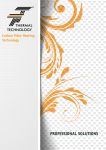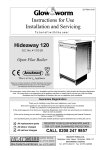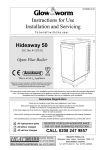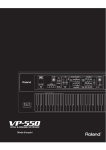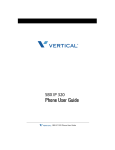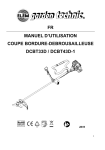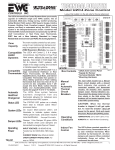Download Xtrafast 96-120 Installation & Service Manual Boilers - Glow-worm
Transcript
2000221595.11.01 Instructions for Use Installation and Servicing Hab 255a To b e l e f t w i t h t h e u s e r 96 120 G.C. No. 47-047-25 G.C. No. 47-047-26 Fanned Flue Combination Boiler This is a Cat II2H3+ Appliance The instructions consist of three parts, User, Installation and Servicing Instructions, which include the Guarantee Registration Card. The instructions are an integral part of the appliance and must, to comply with the current issue of the Gas Safety (Installation and Use) Regulations, be handed to the user on completion of the installation. Guarantee Registration Thank you for installing a new Glow-worm appliance in your home. Glow-worm appliances' are manufactured to the very highest standard so we are pleased to offer our customers' a Comprehensive First Year Guarantee. In the centre pages are to be found your Guarantee Registration Card, which we recommend you complete and return as soon as possible. If this card is missing you can obtain a copy or record your registration by telephoning the Heatcall Customer Service number 01773 828100. Our Guarantee gives you peace of mind plus valuable protection against breakdown by covering the cost of: ✔ ❑ ✔ ❑ ✔ ❑ All replacement parts All labour charges All call-out charges REGISTER YOUR GLOW-WORM APPLIANCE FOR 1ST YEAR GUARANTEE PROTECTION CALL 0208 247 9857 Customer Services: Tel: (01773) 828100 One Contact Local Service Fax: (01773) 828070 Hepworth Heating Ltd., Nottingham Road, Belper, Derbyshire. DE56 1JT General/Sales enquiries: Tel: (01773) 824141 Fax: (01773) 820569 Important Information Testing and Certification This boiler is tested and certificated for safety and performance. It is therefore important that no alteration is made to the boiler, without permission, in writing, from Hepworth Heating Ltd. Any alteration not approved by Hepworth Heating Ltd., could invalidate the certification, boiler warranty and may also infringe the current issue of the Statutory Requirements. The requirements are: The installation of this boiler must be carried out by a competent person in accordance with the current rules in force in the countries of destination at the time of installation. Manufacture's instructions supplied. Manufacture's instructions must not be taken as overriding statutory requirements. Note: The boiler serial number is marked on the label attached to the inside of the drop down door. Refer to the 'Introduction' section for a description of the basic functions of the boiler. The 'Users' section describes how to safely operate the boiler. Mandatory warning for CEE countries Warning: This appliance is designed, approved and inspected to meet the requirements of the market. The identification plate located on the inside of the appliance certifies the origin where the product was manufactured and the country for which it is intended. If you see any exception to this rule, please contact your nearest Glow-worm dealer. Thank you in advance for your assistance. CE Mark This boiler meets the requirements of Statutory Instrument No. 3083 The boiler (Efficiency) Regulations, and therefore is deemed to meet the requirements of Directive 92/42/EEC on the efficiency requirements for new hot water boilers fired with liquid or gaseous fuels. Type test for purposes of Regulation 5 certified by: Notified body ****. Product/production certified by: Notified body ****. The CE mark on this appliance shows compliance with: 1. Directive 90/396/EEC on the approximation of the laws of the Member States relating to appliances burning gaseous fuels. 2. Directive 73/23/EEC on the harmonization of the Laws of the Member States relating to the electrical equipment designed for use within certain voltage limits. 3. Directive 89/336/EEC on the approximation of the Laws of the Member States relating to electromagnetic compatibility. Substances Hazardous to Health The adhesives and sealants used in this appliance are cured and give no known hazard in this state. INSULATION PADS/CERAMIC FIBRE, GLASSYARN, MINERAL WOOL These can cause irritation to skin, eyes and the respiratory tract. If you have a history of skin complaint you may be susceptible to irritation. High dust levels are usual only if the material is broken. Normal handling should not cause discomfort, but follow normal good hygiene and wash your hands before eating, drinking or going to the lavatory. If you do suffer irritation to the eyes or severe irritation to the skin seek medical attention. The insulation is composed of non-combustible material. Spare Parts REMEMBER, When replacing a part on this appliance, use only spare parts that you can be assured conform to the safety and performance specification that we require. Do not use reconditioned or copy parts that have not been clearly authorised by Hepworth Heating Ltd. 2000221595 2 Contents CONTENTS INSTRUCTION FOR USE INSTALLATION INSTRUCTIONS SERVICING INSTRUCTIONS DESCRIPTION SECTION Introduction Controls and Lighting Clock-timer instructions for use Draining Safety Devices Servicing and Maintenance PAGE No. 4 5 6 6 6 7 Technical Data Dimensions Heating System Design Domestic Hot Water System Design Boiler Schematic Boiler Location, Flue and Ventilation Fixing Jig Pack Piping System Installation Boiler Installation Flue Installation Electrical Connection Commissioning Safety Devices Changing Gas Type Settings 1 2 3 4 5 6 7 8 9 10 11 12 13 14 15 8 9 9 10 10 11 12 12 14 14 17 18 22 22 23 Routine Cleaning and Inspection Fault Finding Wiring Diagram Replacement of Parts Spare Parts 17 18 19 20 21 24 27 29 30 40 3 2000221595 Introduction The XTRAFAST 96 and 120 boiler is a wall mounted modulating combination boiler with electronic ignition providing central heating and instantaneous hot water. The boiler is equipped with a 4 litre domestic hot water storage vessel that ensures maximum hot water temperature stability during domestic demand. of 3mm on both poles. The switch should be readily accessible and preferably adjacent to the appliance. It should supply the appliance only and be easily identifiable as so doing. Alternatively, an unswitched shuttered socket outlet and 3A fused 3 pin plug, both to the current issue of BS1363 may be used provided that they are not used in a room containing a bath or shower. The boiler is of the II2H3+ category for use with Natural Gas (G20) as distributed in the United Kingdom. Wiring to the boiler must be PVC 85oC insulated cable, not less than 0.75mm2 (24/0.20mm). The boiler has a fan assisted balanced flue which both discharges the products of combustion to and draws the combustion air from the outside of the room. Gas safety (Installation and use) Regulations The boiler is suitable for top outlet flue connection only. In your interests and that of gas safety, it is the law that ALL gas appliances are installed and serviced by a qualified registered person in accordance with the above regulations. Both the central heating and domestic hot water temperature are user adjustable from the boiler control panel. Gas leak or fault Domestic hot water demand always has priority over heating demand. If a gas leak or fault exists or is suspected, turn the boiler off and consult the local gas supply company or your installation/ service company. The boiler is designed for use as part of a sealed water central heating system with fully pumped circulation. The pump, expansion vessel and associated safety devices are all fitted within the boiler. Air in the heating system The boiler can be installed against either an external wall or on an adjacent inside wall, that is, the flue system will pass directly to the rear or to either side to the terminal fitted on the outside wall face. Persistent air in the heating system may indicate leaks in the system or corrosion taking place. Call your Installation/Servicing company. The installation must be carried out by a competent person in accordance with the relevant requirements of The Building Regulations, The Water Byelaws, The Building Standards (Scotland) Regulations and any applicable local regulations. Overheating safety In the event of a problem, the overheating safety devices cause safety shutdown of the boiler. If this happens, call your Installation/Servicing company. These instructions should be carefully followed for the safe and economical use of your boiler. Boiler controls The control panel, located at the lower front of the boiler casing, see diagram 1, allows the boiler to be started, shut down, controlled and monitored during use. Electrical Supply WARNING: This boiler must be earthed. All system components shall be of an approved type and shall be connected in accordance with the current issue of BS7671 and any applicable local regulations. Flue Do not obstruct the outside terminal of the boiler. All external wiring between the appliance and the electrical supply and earthing requirements shall comply with the current IEE Regulations. Ancillary equipment Connection of the boiler and system controls to the mains supply must be through a common isolator and must be fused 3A, maximum. This method of connection must be by a fused double pole isolating switch, with a minimum contact separation For further information contact your supplier. 1 - On/Off button 2 - Summer/Winter mode selector 3 - Hot water temperature adjuster 4 - Hot water set point display 5 - Graphic display 6 - Heating temperature adjuster 7 - Heating set point display 8 - Display backlight 9 - Clock-timer (refer to clock-timer instructions for use). 1 1.5 Diagram 1 2000221595 4 9900 A range of flue accessories are available including vertical flues, twin-pipe flues, bends etc. Controls and Lighting Lighting the boiler : Make sure that: • The boiler is connected to the electrical supply. • The gas service cock is open. Then follow the instructions below : A Press the On/Off button (1) The pressure must be between 1 and 2 bar. If not, the system must be filled by a competent person. O I 1 3 2 1 24 23 4 22 9 10 Hab 264 14 13 12 11 15 mode 16 8 7 6 5 20 19 18 17 21 1.5 bar 0 1 To stop the boiler : Press button (1) B Press the sur mode button select the winter symbol Appuyer mode pourto sélectionner la position hiver Appuyer mode pourto sélectionner la position été Press the sur mode button select the summer symbol 1.5 bar 10 °C mode The actual temperature Température actuelle of thele heating system dans circuit chauffage The flamelorsque symbolle appears Apparaît brûleur when the boiler is running est en fonctionnement Adjusting the hot water temperature C Press + or adjust theajuster maximum temperature Appuyer sur- to + ou - pour la température of the hotde water °C to 60 °C) maximale l'eau(38 chaude sanitaire (38°C à 60°C) 1.5 bar mode Illuminates when Apparaît lorsque le the boiler lights brûleur fonctionne Adjusting the heating temperature Press + orsur - to adjust theajuster maximum temperature Appuyer + ou - pour la température of the heating (38°Cdu to circuit 87°C) chauffage maximale souhaitée Visual indication set temperature Visualisation de laof température demandée 50 Setting to the WINTER position (Heating + hot water) Visual indication set temperature Visualisation de laof température demandée 60 mode °C °C mode Hab 261 Setting to the SUMMER position (Hot water only) To obtain domestic hot water, open a hot water tap. Hot water always has priority over central heating. 5 2000221595 Clock-timer instructions for use The boiler must be conected to the electrical supply and switched on. Setting the programme "On" and "Off" times Setting the time • Select the "On" times by pushing the white tappets to the outside, see diagram 2. Rotate the clock actuater mechanism clockwise, by hand, until the current time is indicated by the arrow, see diagram 2. • Select the 'Off' times by pushing the white tappets to the inside, see diagram 2. Note: The time is set in 24 hour format, for example, 1300 for 1pm. The clock shown in diagram 2 is set as follows: ON - 07.00am to 09.00am (7-9) OFF - 09.00am to 4.00pm (9-16) ON - 4.00pm to 10.00pm (16-22) To override or advance the clock The clock has a manual On/ Off switch, see diagram 3, which operates as follows : Reg 050 Reg 049 OFF - 10.00pm to 07.00am (22-7) Upper position Heating On/Off as set by the tappets. Middle position Heating Off continuously Lower position Heating On continuously Diagram 2 Diagram 3 Draining Protection against freezing Draining and filling If the boiler is to be out of use for any long periods during severe weather conditions, it is recommended that the whole system, including the boiler, be drained to avoid the risk of freezing. Caution: The boiler is installed as part of a sealed system which must only be drained and filled by a competent person. If in doubt, consult your servicing company. Safety Devices are left connected. The frost protection device will light the boiler when the temperature of the boiler water falls below 6°C. When the temperature reaches 16°C, the boiler stops. Air flow rate safety device If an obstruction, even partial, of the flue occurs, for any reason, the built in safety system of the boiler will turn the boiler OFF and the fan will continue to run. The boiler will be ready to operate when the fault has been cleared. Note : This device works irrespective of any room thermostat setting and will protect the complete heating system. Heating safety valve Overheat safety CAUTION: A heating safety valve with a discharge pipe is fitted to this boiler. In case of boiler overheating, the overheat thermostat will turn the boiler off. The thermostat, located on the heat exchanger flow pipe, will need to be manually reset. To have this done call a qualified service engineer or Heatcall (Glow-worm’s own service organisation) using the telephone number behind the controls cover door or on the front cover of this booklet. The valve MUST NOT BE TOUCHED except by a qualified registered person. If the valve discharges at any time, switch the boiler off and isolate it from the electrical supply. Contact your installation/service company. In case of power supply failure Pressure relief valve The boiler no longer operates. As soon as power supply is restored, the boiler will be automatically restarted. CAUTION: A domestic hot water pressure relief valve, with a discharge pipe is fitted to this boiler. Frost protection The valve MUST NOT BE TOUCHED except by a qualified registered person. If the valve discharges at any time, switch the boiler off and isolate it from the electrical supply. Contact a qualified service engineer or Heatcall (Glow-worm’s own service organisation) using the telephone number behind the controls cover door or on the front cover of this booklet. The XTRAFAST has a built in frost protection device that protects the boiler from freezing. If the boiler is to be left and there is a risk of frost, ensure that the gas and electrical supplies 2000221595 6 Servicing and Maintenance To ensure the continued efficient and safe operation of the appliance it is recommended that it is checked and serviced as necessary at regular intervals. The frequency of servicing will depend upon the particular installation conditions and usage, but in general once a year should be enough. Cleaning WARNING: This appliance contains metal parts (components) and care should be taken when handling and cleaning with particular regard to edges of sheet metal parts to avoid any possiblity of personal injury. If this appliance is installed in a rented property there is a duty of care imposed on the owner of the property by the current issue of the Gas Safety (Installation and Use) Regulations, Section 35. The boiler casing can be cleaned using a mild liquid detergent with a damp cloth, followed by a dry cloth to polish. Do not use any form of abrasive or solvent cleaner as you may damage the paint work. Servicing/maintenance should be carried out by a competent person in accordance with the rules in force in the countries of destination. Boiler casing To obtain service, please call your installer or Heatcall (Glowworm’s own service organisation) using the telephone number behind the controls cover door. CAUTION. Do not remove or adjust the casing in any way, as incorrect fitting may result in faulty operation. If in doubt, consult your installation/service company. Please be advised that the ‘Benchmark’ logbook should be completed by the installation engineer on completion of commissioning and servicing. All CORGI Registered Installers carry a CORGI ID card, and have a registration number. Both should be recorded in your boiler Logbook. You can check your installer is CORGI registered by calling CORGI direct on: 01256 372300. Heating output ajustable from ... (kW) 10,4 11,7 to ... (kW) 27,6 34,6 from ... (BTU/H) 35,485 39,920 to ... (BTU/H) 94,170 118,053 Efficiency (%) ** ** Maximum heating temperature (°C) 87 87 Expansion vessel effective capacity (l) 7 12 Expansion vessel charge pressure (bar) 0,5 0,5 Maximum system capacity at 75°C (l) 160 275 Safety valve, maximum service pressure (bar) 3 3 Products outlet diameter (mm) 60 60 Fresh air inlet diameter (mm) 100 100 Ø Burner injector Inlet pressure Burner pressure Gas rate maximum Gas rate minimum (mm) (mbar) (mbar) (m3/h) (m3/h) Electrical supply Maximum absorbed power Level of protection (V) (W) Fuse rating Hot water Lift weight Total weight (inclusive water) Hot water output automatically variable from ... (kW) 10,4 11,7 to ... (kW) 27,6 34,6 from ... (BTU/H) 35,485 39,920 to ... (BTU/H) 94,170 118,053 Maximum hot water temperature (°C) 60 60 Specific flow rate (for 30°C temp rise) (l/min.) 13,2 16,5 Threshold flow rate (l/min.) 1 1 Nominal water flow rate (l/min.) 11,3 16,5 Maximum supply pressure (bar) 8 8 Minimum operating pressure (bar) 0,7 0,7 XTRAFAST 120 Natural Gas (G20) XTRAFAST 96 XTRAFAST 120 Heating XTRAFAST 96 1 Technical Data 1,20 20 13,8 3,20 1,32 1,20 20 14,1 3,98 1,48 230 220 IP44 230 220 IP44 125mAT 125mAT Xtrafast 96 51.2kg (112.9lb) Xtrafast 120 **.*kg (**.**lb) **.*kg (**.**lb) **.*kg (**.**lb) The Seasonal Efficiency Domestic Boilers UK (SEDBUK) is **.*%. The value is used in the UK Government's Standard Assesssment Procedure (SAP) for energy rating of dwellings. The test data from which it has been calculated have been certified by B.S.I. 7 2000221595 1 Technical Data PUMP 96 1 50 2 3 40 4 5 30 20 Pom 010 a Available pressure (kPa) between heating supply and return lines 60 10 0 0 200 400 600 (10 kPa = 1 m WG) 800 1000 1200 Flow rate through heating system (I/h) PUMP 120 70 60 50 5 4 3 1 2 40 30 20 Pom 058 Available pressure (kPa) between heating supply and return lines 80 10 0 0 200 (10 kPa = 1 m WG) 1 Bypass fully shut 400 600 800 1000 1200 Flow rate through heating system (I/h) 2 Open 1/4 turn 3 Open 1/2 turn 4 Open 1 turn 5 Open 2 turns Diagram 4 2000221595 8 2 Dimensions 65 7422 The XTRAFAST is delivered in three separate packages: - the boiler - the fixing jig - the flue system 234 890 Lifting Weight: 51,2 kg X = 470 (96) 552 (120) X 0 38 Diagram 5 3 Heating System Design • The total volume of water permitted for the heating system depends, amongst other things, on the static head in the cold condition. The expansion vessel on the boiler is pressurised at 0,5 bar (corresponding to a static head of 5 m w.g.) and allows a maximum system volume of 160 litres for an average temperature of 75°C and a maximum service pressure of 3 bar. This pressure setting can be modified at commissioning stage if the static head differs. An additional expansion vessel can be fitted to the system if required, see diagram 8.2. • The XTRAFAST is compatible with any type of installation. • Heating surfaces may consist of radiators, convectors or fan assisted convectors. • The XTRAFAST can be piped directly to an underfloor heating system without the need for a mixing bottle. The maximum central heating flow temperature can be set to 53°C.on the boiler printed circuit board during commissioning. • Pipe sectional areas shall be determined in accordance with normal practices, using the output/pressure curve (diagram 4). The distribution system shall be calculated in accordance with the output requirements of the actual system, not the maximum output of the boiler. However, provision shall be made to ensure sufficient flow so that the temperature difference between the flow and return pipes be less than or equal to 20°C. The minimum flow is 400 l/h. • Provision shall be made for a drain valve at the lowest point of the system. • Where thermostatic radiator valves are fitted, not all radiators must be fitted with this type of valve, and in particular, where the room thermostat is installed. • In the case of an existing installation, it is ESSENTIAL that the system is thoroughly flushed prior to installing the new boiler. • The piping system shall be routed so as to avoid any air pockets and facilitate permanent venting of the installation. Bleed fittings must be provided at every high point of the system and on all radiators. Filling the system A filling device must be provided to fill the system, see diagram 8.2. 9 2000221595 4 Domestic Hot Water System Design • Copper tubing or plastic hep2o may be used for the domestic hot water system. Unnecessary pressure losses should be avoided. bar, but under reduced flow rate. Best operating comfort will be obtained from a supply pressure of 1 bar. 'Hard Water Areas' • A flow restrictor limiting the flow through the boiler to a maximum of 12 l/min is fitted to the boiler. In areas where the water is 'hard', more than 200mg/litre, it is recommended that a proprietary scale reducer is fitted in the cold water supply to the boiler. • The boiler will operate with a minimum supply pressure of 0,7 1 - Domestic thermistor 2 - Three way valve 3 - Gas valve 4 - Ignition module 5 - Heating element 6 - Micro accumulation vessel 7 - Burner 8 - Ignition electrode 9 - Combustion chamber 10 - Micro accumulation vessel thermistor 11 - Main heat exchanger 12 - Air pressure switch 13 - Heating safety valve (3 bar) 14 - Electronic control (PCB) 15 - Domestic water flow sensor 16 - Bypass 17 - Domestic heat exchanger 18 - Pump 19 - Expansion vessel 20 - Heating thermistor 21 - Overheat safety thermostat 22 - Flame sense electrode 23 - Fan 24 - Domestic safety valve (10 bar) 25 - Loss of water sensor 19 A - Heating return B - Cold water inlet C - Heating flow D - Domestic hot water outlet E - Gas 10026 5 Boiler Schematic 12 23 11 10 21 9 7 22 8 4 20 18 6 5 3 2 16 17 1 15 14 25 13 A B 2000221595 10 24 C D E Diagram 5.1 6 Boiler Location, Flue and Ventilation 6.2 Terminal guard If the appliance has to be stored for any length of time before installation it should be kept in a safe place where it will not be a hazard to persons or obstruct any access. Care should be taken when handling or moving the appliance taking note of the trucking points on the sides of the carton. A terminal guard is required if persons could come into contact with the terminal or the terminal could be sublject to damage. If a terminal guard is required, it must be positioned to provide a minimum of 50mm clearance from any part of the terminal and to be central over the terminal. 6.1 Clearances The position of the boiler must be such that there is adequate space for servicing. Teminal guard type K3 supplied by: Tower flue components Ltd. Morley road Tonbridge Kent TN9 1RA The recommended clearances are: 20 mm either side of the boiler. 600 mm at the front of the boiler. 300 mm below the boiler. 6.3 Flue options 25 mm above the flue elbow. There are various flue systems to choose from as follows: Note: The boiler must be mounted on a flat wall which is sufficiently robust to take its weight when full, that is, ** kg. If in doubt, expert advice should be obtained. In the event of the wall being found not suitable. Standard horizontal flue pack. Standard horizontal extended flue pack. Vertical flue pack. Note: It is permissible to install the boiler with smaller clearances than those quoted above PROVIDING that adequate consideration is given for Servicing/Repairs at a later date. If any doubt exists, contact the Glow-worm Technical Helpline 01773 828100. Twin flue pack. Extentions, 90° and 45° bends. Flue options and accessories. The minimum acceptable spacings from the terminal to obstructions and ventilation openings are shown in diagram 6.1. For detailed information refer to flue guide Part No. 223278. The boiler must be installed so that the terminal is exposed to the external air. The boiler can be fitted in a cupboard or compartment without the need for permanent ventilation. 6.4 Cupboard or compartment ventilation MINIMUM SITING DIMENSIONS FOR THE POSITIONING OF FLUE TERMINALS MM A DIRECTLY BELOW, ABOVE OR HORIZONTALLY TO AN OPENING, AIR BRICK, OPENING WINDOWS, AIR VENT, OR ANY OTHER VENTILATION OPENING 300 B BELOW GUTTER, DRAIN/SOIL PIPE 75 C BELOW EAVES 200 D BELOW A BALCONY OR CAR PORT 300 E FROM VERTICAL DRAIN PIPES AND SOIL PIPES 300 F FROM INTERNAL CORNERS AND EXTERNAL CORNERS 300 G ABOVE ADJACENT GROUND OR BALCONY LEVEL 300 H FROM SURFACE FACING THE TERMINAL 600 I FACING TERMINALS 1200 J FROM OPENING (DOOR/WINDOW) IN CAR PORT INTO DWELLING 1200 K VERTICAL FROM A TERMINAL 1500 L HORIZONTALLY FROM A TERMINAL 600 2816 Should any doubt exist as to the permissible position of the terminal, contact the Glow-worm Technical Helpline 01773 828100. C A B,C B,C G A F G E K F F A K L G G L K G UNDER CAR PORT etc. D J F K H,I Diagram 6.1 11 2000221595 7 Fixing Jig Pack The fixing jig is made up, from left to right, as follows: A - Heating return fitting with isolating valve(v) and drain knob (u). B - Cold water inlet fitting with isolating valve (m)and factory fitted flow regulator and filter (not shown). C - Heating flow fitting with isolating valve (q), drain knob (r) and safety valve (s1). D - Domestic hot water outlet fitting with safety valve (s2). E - Gas fitting. Other components within the fixing jig pack. F - Hanging bracket G - wall template H - copper connections J - sealing washers G K - sealant (putty) SCREW (4 OFF) A ISOLATING VALVE PLATE u C K J 9880 9959 F r B E D q v s1 m s2 H COPPER LEFT HAND SUPPORT BRACKET CONNECTIONS AND WASHERS (7 OFF) RIGHT HAND SUPPORT BRACKET THE FIXING JIG SHOWN ASSEMBLED Diagram 7.1 8 Piping System Installation 8.1 Fixing jig bracket are fitted to a flat and true wall area for correct alignment with the boiler. If this is cannot be achieved it is acceptable to pack out the service cock bracket to obtain the correct alignment. • Remove the contents of the fixing jig pack. • Secure the left and right hand support brackets to the isolating valve plate with the securing screws (4 OFF) supplied, see diagram 7.1. • Position the wall template, see diagram 8.1. • Connect the six copper connections and sealing washers to the isolating valves, see diagram 7.1. • Drill, plug and fix the hanging bracket to the wall using suitable screws. • Heating system connections - Pipe diam. 22mm • Check that the hanging bracket is level. • Hot water system connections - Pipe diam. 15mm • Drill plug and fix the fixing jig to the wall. • Gas connection - Pipe diam. 22mm • For horizontal flue system, mark the position for the flue hole as follows: • Mark the position of the holes for the hanging bracket and jig. • Domestic safety valve connection - Pipe diam.15mm 8.3 Flue to rear of boiler • Heating safety valve connection - Pipe diam. 15mm • Mark correct position of hole from template. 8.2 Wall template 8.4 Flue to side of boiler • Remove the wall template, follow the instructions given on the wall template. • Mark the horizontal centre line for the hole on the rear wall. Extend the horizontal centre line to the side wall and mark the vertical centre line of flue hole as shown in diagram 8.1. • Note: It is important the hanging bracket and service cock 2000221595 12 8 Piping System Installation 9684 8.5 Cutting the flue hole • Making allowance for the slope of the flue, cut hole in external wall, preferably using a core drill. For installations with internal and external access use a 105 mm diameter core drill. 105 For installations with internal access only use a 125 mm diameter core drill. 8.6 Important 65 20 When cutting the flue hole and when extending the flue centre line to a side wall, remember that the flue system must have a fall of about 35 mm per metre of flue DOWNWARD towards the terminal. There must NEVER be a downward incline towards the boiler. 234 8.6 Terminal position 890 The minimum acceptable spacings from the terminal to obstructions and ventilation openings are shown in diagram 6.1. The boiler must be installed so that the terminal is exposed to the external air. Should any doubt exist as to the permissible position of the terminal, contact the Glow-worm Technical Helpline 01773 828100. 8.7 Water connection Connect the system pipework to the copper connections on the fixing jig observing the correct flow and return format as shown in diagram 8.2. Do not subject the isolating valves to heat. 8.8 Heating safety valve and domestic safety valve discharge, refer to diagram 8.3. 470 (96) 552 (120) Diagram 8.1 Tee the domestic safety valve outlet pipe to the heating safety valve outlet pipe and extend horizontally to the outside wall. Hot Connect the safety valve discharge pipe to the outlets of both the heating safety valve and the domestic water safety valve, the discharge must be extended using not less than 15mm. pipe, to discharge in a visible position outside the building, facing downward preferably over a drain. Domestic water Boiler The pipe must have a continuous fall and be routed to a position so that any discharge of water, possibly boiling or steam, cannot create any danger to persons, damage to property or external electrical components and wiring. Tighten all pipe connection joints. 8.9 Gas connection Return • The supply from the governed gas meter must be of adequate size to provide a constant inlet working pressure of 20 mbar (8 in w.g.). Filling device Heating circuit Flow control valve To avoid low gas pressure problems, it is recommended that the gas supply is connected using 22 mm pipe. • On completion, the gas installation must be tested using the pressure drop method and purged in accordance with the current issue of BS6891. HEATING SAFETY VALVE 3 bar) 8.10 Gas Safety (Installation and use) Regulations In your interests and that of gas safety, it is the law that ALL gas appliances are installed and serviced by a competent person in accordance with the above regulations. Bypass valve Drain point Sch 173a Additional expansion vessel (if required) Cold supply WARNING. It must not discharge above an entrance or window or any type of public access area. Diagram 8.2 DOMESTIC SAFETY VALVE (10bar) Diagram 8.3 13 2000221595 9 Boiler installation 9.1 Statutory requirements The installation of this boiler must be carried out by a qualified registered person in accordance with the relevant requirements of the current issue of: The Gas Safety (Installation and Use) Regulations The Building Regulations The local water company Byelaws The Building Standards Regulations (Scotland) The Health and Safety at Work Act 9.2 Sheet metal parts WARNING. When installing or servicing this boiler, care should be taken when handling the edges of sheet metal parts to avoid the possibility of personal injury. 9.3 Installing the boiler Prior to starting work, the system must be thoroughly flushed using a propriety cleanser such as Sentinel X300 to eliminate any foreign matter and contamination e.g. metal filings, solder particles, oil, grease etc. Note. Solvent products could cause damage to the system. The boiler pack consists of the boiler, base panel, literature, sealing washers and securing screws. • Lay boiler on its back. • Remove all packaging from around the boiler. • Remove front panel, put in a safe place to avoid damaging it. • Ensure the plastic plugs are removed from water and gas pipes. NOTE: There will be some spillage of water. • Remove transportation timber support bar from bottom rear of boiler. • If required the boiler can be stood upright supported by extending the legs at the front bottom of the boiler. • Engage boiler upper part onto the hanging bracket. • Fit the washers between the boiler pipes and the inlet and outlet fittings on the fixing jig and connect the various couplings between the boiler and jig. • Fit the base panel, hook in at the rear secure with the four self tapping securing screws at the front. 2000221595 14 10 Flue Installation 10.1 Top outlet flue - kit 86285 The boiler is only suitable for top outlet flue connection. 70mm 70mm 10.2 Rear flue systems (Refer to diagram 10.1). To calculate the length when flueing to the rear measure wall thickness e plus 160 mm for the outer air duct and e plus 244 mm for the inner flue duct measurement. 10.3 Flue systems Right or Left (Refer to diagram 10.1). To calculate the length when flueing to the side measure wall thickness e plus inside of wall to side of boiler a add 145(mm) for the outer air duct and wall thickness e plus inside of wall to side of boiler a add 229(mm) for the inner flue duct measurement. • Refer to diagram 10.2 (Table A) for cutting lengths of both flue duct and air duct pipes for each of the various flue options available. When the dimension X measured on site is greater than that given in diagram 10.2 ( Table B ), extensions will be required as necessary. a a e X X 9659 Important: All flue cutting lengths must be measured from the terminal end of the flue pipes, see diagram 10.2 (D). e Diagram 10.1 Calculation of flue cutting lengths for extended flue •Using the correct number of extension kits as (Table B), measure dimensions a and e, see diagram 10.1. Cut both the flue duct and air duct pipes to the dimensions given in (Table C) Table A: Flue cutting lengths (mm) (D) Rear flue Air Duct pipe : e + 160, Flue duct pipe : e + 244 Note : maximum distance 'x' without extension 756 mm Side flue (right or left) Air Duct pipe : e + a + 145, Flue duct pipe : e + a + 229 Note : maximum distance 'x' without extension 990 mm AIR DUCT OuterPIPE pipe Ven 089 Important: All cutting lengths should be measured from the push fit joint end of the extension pipe. Do not leave any burrs or sharp edges on the cut ends of the pipes. Note : maximum horizontal flue length without bends is 3.5m. Cutting length FLUEInner DUCT pipePIPE Cutting length Table B: Number of extension kits required Flue option Side flue (left or right) Dimension 'X' 991 to 1991 mm 1991 to 2991 mm No. of extension kits 1 2 Note: Maximum flue length for 120 model is 2 metres Table C: Flue extention cutting lengths (mm) Rear flue option Air Duct pipe : e + a - 755, Flue duct pipe : e + a -755 Note : maximum distance 'x' without extension 990 mm Diagram 10.2 15 2000221595 10 Flue Installation Pho 451 10.4 Installation of flue assembly A • Fit rubber sealing collar (F), see diagram 10.3, into groove at the outer end of pipe (A). • Fit air duct pipe (A) into wall with groove to the outside. B • Pull pipe inwards to bring rubber sealing collar hard up against external wall, see diagram 10.4. • Fit internal plastic flange (G) onto air duct pipe. Push along the pipe until engaged against internal wall. E • From inside, insert flue duct pipe (B) into air duct pipe. C • Fit both ‘O’ rings (J) into the flue elbow (C), one at the inlet, one at the outlet. By necessity, they are a loose fit, apply a small amount of silicone grease to each ‘O’ ring when fitting. H • Fixing collar (D) over air duct pipe (A) and elbow (C) ensuring it is the correct way round (Note: the fixing collar can only be fitted one way due to different diameters of the flue elbow and air duct). G F D I J The flue kit 86285 is 1000 mm long and comprises: - Air duct pipe .......................................................... A - Flue duct pipe ........................................................ B - Flue elbow .............................................................. C - Fixing collar ............................................................. D - Locking clips ............................................................ E - External rubber sealing collar ............................... F - Internal flange ....................................................... G - Gasket ..................................................................... H - Screws ....................................................................... I - 'O' rings ..................................................................... J • Take hold of the flue duct pipe and push gently onto the elbow outlet taking care not to tear the ‘O’ ring. • Open fixing collar (D) and locate between elbow and air duct pipe (A). Close fixing jig. • Engage the two fixing clips (E) onto the collar (D) and press down to lock into position. Secure clips with screws provided. Important: If the flue has been cut, ensure that there are no burrs that could damage the ‘O’ ring. Diagram 10.3 Pho 087 • For flue systems less than 1,5 m long, leave the restrictor (a) fitted in the fan outlet, see diagram 10.5. • Remove the backing from the self adhesive gasket (H) and carefully fit gasket to base of flue elbow. • Fit elbow onto boiler and secure with the four screws (I). Diagram 10.4 Concentric flue system The maximum permissible length (L) for the concentric flue system is 3.5 m. For flue systems up to 1,5 m length, the restrictor (a) supplied fitted to the boiler, inside the fan outlet, must be left in place. For longer flue systems, the restrictor must be removed. For each 90° flue elbow used, (or two 45° elbows) the maximum permissible length (L) must be reduced by 1 metre. Hab 249a L Gasket 23 4 65 a Diagram 10.5 2000221595 16 11 Electrical Connection Warning. This boiler must be earthed The boiler is supplied with a mains lead attached. Standard colours are Brown - Live, Blue - Neutral, Green and Yellow - Earth. 9881 All system components must be of an approved type. Electrical components have been tested to meet the equivalent requirements of the BEAB. Connection of the whole electrical system and any heating system controls to the electrical supply must be through a common isolator. The boiler is supplird with a mains lead attached. Connect this to the electrical supply. Isolation should preferably be by a double pole switched fused spur box having a minimum contact separation of 3 mm on each pole. The fused spur box should be readily accessible and preferably adjacent to the boiler. It should be identified as to its use. 10036 Diagram 11.1 A fused three pin plug and shuttered socket outlet may be used instead of a fused spur box provided that: a) They are not used in a room containing a fixed bath or shower. b) Both the plug and socket comply with the current issue of BS1363. SIDE CLIPS The mains electrical supply must be maintained at all times in order to provide domestic hot water. Do not interrupt the mains supply with a time switch or programmer. WARNING: ON NO ACCOUNT MUST ANY EXTERNAL VOLTAGE BE APPLIED TO ANY OF THE TERMINALS ON THE HEATING CONTROLS CONNECTION PLUG. Diagram 11.2 Leave link in place for no external controls. 9879 Warning: This appliance must be wired in accordance with these instructions. Any fault arising from incorrect wiring cannot be put right under the terms of the Glow-worm guarantee. 11.1 External controls The XTRAFAST boiler is designed to operate at maximum efficiency at all times, but will be most efficient and economical when connected to a room thermostat. The boiler will work for heating without a room thermostat being connected provided that the wire link fitted between the two terminals of the connector (E) is left in place, see diagram 11.3. E Alternatively, a 230V room thermostat can be used but do not make any connection to the compensating resistor, see diagram 11.3. Without room thermostat E ON NO ACCOUNT must any electrical voltage be applied to any of the terminals of the external controls plug. 10023 IMPORTANT With VOLTAGE FREE room thermostat To gain access to the external control connections, unclip side clips and hinge up control panel cover, see diagram 11.2. °C E Remote Control Diagram 11.3 A remote control is available for the Xtrafast. Part no. xxxxxx. If the remote control is fitted the wire link must be in place on connector (E), and the Switch SW3 must be adjusted, see diagram 11.4. SW3 ON 11.2 Electrical test Carry out preliminary electrical system checks as below: 1 2 TOGGLES 9878 1. Test insulation resistance to earth of mains cables. 2. Test earth continuity and short circuit of all cables. 3. Test the polarity of the mains. Set 1 & 2 OFF for normal operation Note: For further information, see the building regulations 1991 - Conservation of Fuel and Power - 1995 edition - appendix G, Table 4b. 17 ON OFF 1 - Remote Control with without 2 - Parameters open locked Diagram 11.4 2000221595 12 Commissioning 9323 Please ensure the “Benchmark” logbook is completed and left with the user. The commissioning and first firing of the boiler must only be done by a qualified registered person. Gas valve settings. Refer to Section 15 "Settings". Gas installation It is recommended that any air is purged from the supply at the gas inlet test point on the gas valve, see diagram 12.1. Filling the system 1 to 8 Diagram 12.1 Hab 265 1 GAS INLET TEST POINT Press the mains 'On/Off' button The warning light will illuminate The display will indicate 0 bar pressure in the system O 3 2 1 24 23 4 22 0 1 16 15 10 9 20 19 18 17 8 7 6 5 21 14 13 12 11 0.0 bar mode I ➜ m q Open the boiler isolating valves (v and q), the slot of the screw corresponds to flow direction. Fully open valve m by turning anti-clockwise. The pressure must be between 1 and 2 bar Open the system filling loop and fill the system until the pressure indicated on the display is between 1 and 2 bar. Hab 265 4 v Undo cap on automatic air vent on top of pump and leave undone. Reg 008 2 ➜ 3 2000221595 18 1.5 bar mod 12 Commissioning 5 Bleed each radiator to remove the air, re-tighten bleed screws. 6 Leave the cap on the pump auto air vent open. 7 Open various hot water taps to bleed system. ➜ Ins 062 Reg 008 Hab 265 Make sure the display indicates a system pressure of between 1 and 2 bar. Re-fill system as necessary. (The warning light will extinguish at 1 bar). The pressure must be between 1 and 2 bar O 3 2 1 24 23 4 22 14 13 12 11 19 15 10 9 20 19 18 17 8 7 6 5 21 1.5 bar mode I 0 1 16 Ins 061 ➜ 8 2000221595 12 Commissioning Lighting the boiler: Make sure that: • The boiler is connected to the electrical supply. • The gas service cock is open. Then follow the instructions below : A Press the On/Off button (1) The pressure must be between 1 and 2 bar. If not, the system must be filled by a competent person. O 3 2 1 24 23 4 22 9 1 14 13 12 11 Hab 264 15 10 0 1 16 8 7 6 5 20 19 18 17 21 1.5 bar mode I To stop the boiler: Press button 1. Setting to the WINTER position (Heating + hot water) • Adjust heating temperature to maximum 87°C. • Check that any external controls, if fitted, are calling for heat (set room thermostat to maximum). Press the mode button to select BAppuyer sur modethepour winter symbolla position hiver sélectionner • Allow the temperature to rise to the maximum value, with all radiator valves open. The temperature rise will cause release of the gases contained in the water of the central heating system. • Gases driven towards the boiler will be automatically released through the automatic air vent. 10 °C TheTempérature actual temperature actuelle dans le circuit chauffage of the heating system 1.5 bar • The gases trapped at the highest point of the system must be released by bleeding the radiators. Check the burner gas rate required, ten minutes from lighting. Refer to Data Label on electrical controls box. Should there be any doubt about the gas rate it should be checked at the meter. mode On reaching maximum temperature, the boiler should be turned off and the system drained as rapidly as possible whilst still hot. Illuminates when Apparaît lorsque le the brûleurlights fonctionne boiler • Refill system to a pressure of between 1 and 2 bar and vent as before. Adjusting the heating temperature C • Restart boiler and operate until a maximum temperature is reached. Shut down boiler and vent heating system. If necessary, top up heating system and make sure that a pressure of at least 1 bar is indicated when system is COLD. Press + or - to adjust the maximum Appuyer sur + ou - pour ajuster la température temperature of du thecircuit heating (38°C to 87°C) maximale souhaitée chauffage Visual indication of set temperature Visualisation de la température demandée 2000221595 mode Hab 261 60 °C 20 13 Safety Devices General safety devices The XTRAFAST incorporates a visual display that indicates fault conditions, should they occur. 13.4 Air flow rate safety device In the event of a fault, the display will indicate, by means of pictograms and/or letters and numbers, exactly in which area the fault lies. If an obstruction, even partial, of the flue occurs, for any reason whatsoever, the built in safety system of the boiler will turn the boiler OFF and the fan will continue to run. Should the boiler fail to operate during Commissioning, the most likely fault is that the gas supply to the boiler has not been turned on or purged sufficiently or that there is no pressure in the heating system. These are indicated as follows : The boiler will be ready to operate when the fault has been cleared. 13.5 Overheat safety 13.1 No gas supply ➜ In case of boiler overheating, the overheat thermostat will turn the boiler off. The thermostat will need to be manually reset. To do this remove the front panel and sealed chamber cover, locate the reset button on the heat exchanger flow pipe, refer to Sections 16.3, 16.4, 16.5 and diagram 19.15. This will be indicated on the display as a pictogram of a spark. To rectify this, proceed as follows: 13.6 In case of power supply failure • Switch off the boiler at the On/Off push button. • Rectify the gas supply problem. O I The boiler no longer operates. 1 As soon as power supply is restored, the boiler will be automatically restarted. • Restart the boiler by pressing the On/Off button. 13.7 Frost protection The XTRAFAST has a built in frost protection device that protects the boiler from freezing. If the boiler is to be left and there is a risk of frost, ensure that the gas and electrical supplies are left connected. The frost protection device will light the boiler when the temperature of the boiler water falls below 6°C. When the temperature reaches 16°C, the boiler stops. 13.2 Insufficient system pressure 0.3 bar This will be indicated on the display as a flashing warning indicating the system pressure is low. To rectify this the system must be re-filled, refer to 'Section 12 Commissioning'. Note : This device works irrespective of any room thermostat setting and will protect the complete heating system. 13.3 Other faults These are indicated on the display by a fault code and a telephone symbol. Further information on the fault codes can be found in the 'Section 17 Fault Finding'. 21 2000221595 14 Changing Gas Type Should it become necessary to change the gas type, a modification kit will be required. This modification must only be carried out by a suitably qualified engineer. Conversion natural Gas (G20) to G30/G31 Part No. 86216. 15 Settings 9669 Bypass The XTRAFAST boiler has a built-in bypass. This must be adjusted according to the requirements of the system, refer to the flow rate pressure curve (diagram 4). The boiler is supplied with the built-in bypass open a half a turn. It is adjusted by turning the bypass screw (a), see diagram 15.1. Turn the screw clockwise to close the bypass. When using thermostatic radiator valves (TRV’s) on all of the radiators, it is essential that a separate, adjustable bypass of 15 mm minimum diameter is fitted between the flow and return of the heating circuit, see diagram 8.2. Any bypass must be fitted before system controls. a Diagram 15.1 2000221595 22 16 Routine Cleaning and Inspection 10022 To ensure the continued efficient and safe operation of the boiler it is recommended that it is checked and serviced at regular intervals. The frequency of servicing will depend upon the particular installation conditions and usage, but in general once a year should be enough. It is the law that any servicing is carried out by a competent person. All parts are replaced in reverse order to removal. 16.1 Products of combustion check, refer to diagram 16.1 Note: To obtain a products of combustion reading, unscrew the left hand sampling point cap on the flue elbow, located on top of boiler. Connect the analyser tube onto sampling point. Switch on the electrical supply and gas supply, then operate the boiler. 9318 On completion of the test switch off the electrical supply and the gas supply, remove analyser tube and replace sampling point cap. PRODUCTS SAMPLING POINT Diagram 16.2 9950 Diagram 16.1 16.2 Service Check and Preparation. • Operate boiler and check for any faults that need to be put right. • Isolate boiler from the gas and electrical supplies. • On completion check all gas-carrying parts for soundness with leak detection fluid. • Remove boiler casing as follows: 16.3 Front panel • Unscrew and remove the two front panel retaining brackets from the top of the boiler. Diagram 16.3 • Remove panel by lifting up and forward. 16.6 Side panels (For ease of access if required) 16.4 Control panel • Unscrew and remove the four screws securing lower grille onto boiler. Unhook grille from rear of boiler and remove. • Lift control panel up and lower forwards to gain access to lower part of boiler. • Remove three screws from front of each side panel. 16.5 Sealed chamber cover • Unclip the toggle clip at the top of each side panel. • Unclip the two toggle clips holding the sealed chamber cover, see diagram. 16.2. • Lift each panel up and then forward to remove. • Lift cover up and off boiler. 16.7 Combustion chamber cover • Unscrew the two screws securing combustion chamber cover to combustion chamber then unclip the two toggle clips, see diagram 16.3. • Remove combustion chamber cover from boiler. 23 2000221595 16 Routine Cleaning and Inspection 16.8 Burner, refer to diagram 16.4. 16.9 Heat exchanger, refer to diagram 16.5. • Undo main gas supply nut from under the sealed chamber. • Disconnect electrical leads from fan. Note: The washer between main burner and main burner gas supply must be kept for use on reassembly. • Unscrew and remove two fan retaining screws from the right hand side edge of fan mounting plate. • Pull off ignition leads from gas control valve. • Remove fan with mounting plate attached by pulling forward and out of boiler. • Slacken but do not remove, two burner support screws at rear of burner chamber using a long blade screw driver. • Remove air pressure switch sensing tube from sensing probe on flue hood. • Ease burner from boiler by lifting up from key hole slots, threading the gas supply and ignition leads through the grommets and pulling forwards, (taking care not to damage the insulation). Before you completly remove the burner pull off flame sense lead from flame sense electrode. • Remove screws securing flue hood to rear panel • Lift flue hood clear of heat exchanger and examine for debris. • Using a soft brush or vacuum clean as required. DO NOT USE ANY TOOL LIKELY TO DAMAGE PAINTED FINISH OF HEAT EXCHANGER. • When refitting burner ensure that the burner locates and seals correctly through the grommets. Note: When re-fitting fan, make sure that the two lugs on the fan mounting plate engage in the flue hood Note: To gain access to injectors for removal, refer to Section, 19.24 in Replacement of Parts. 9661 FAN RETAINING SLOTS 9670 • Clean burner by washing in soapy water. Dry thoroughly before refitting. GROMMETS 9344 MAIN GAS SUPPLY NUT 9665 IGNITION LEADS 9660 9663 9662 9664 BURNER SECURING SCREWS 9667 IGNITION ELECTRODE ASSEMBLY 2000221595 FLAME SENSE ELECTRODE Diagram 16.4 Diagram 16.5 24 16.10 Spark and Sense Gaps 4mm • Check that the spark and sense gaps as shown in diagram 16.6. 16.11 Flue system 9877 16 Routine Cleaning and Inspection 4mm • Check externally to make sure that flue is not blocked • Inspect flue system to make sure that all fittings are secure. 16.12 Operation of fan • Switch on electrical supply and turn on gas. • Light burner by opening a hot water tap. • Check that fan operates when burner lights and stops when it goes out. 16.13 Cold water inlet filter Drain down domestic hot water circuit of boiler only, as follows: SPARK GAP 9876 • Close isolating valve/throttle (m) on cold water isolating cock, see diagram 7.1. Note: This valve is closed when screwed fully clockwise. • Undo connecting nut from boiler cold water inlet connection. • Clean and inspect filter, replace if necessary, see diagram 16.7. 5mm • With both filter and restrictor in place, reconnect connecting pipe to inlet connection and tighten. • Fully open isolating valve/throttle on cold water inlet and check for leaks. Diagram 16.6 9875 SENSE GAP FLOW RESTRICTOR AND COLD WATER INLET FILTER Diagram 16.7 25 2000221595 17 Fault Finding Fault finding must be carried out by a competent person. • There is a permanent mains supply to the boiler. WARNING. Always isolate the boiler from the electrical supply before carrying out any electrical replacement work. • The heating system pressure is at least 1 bar. • The fuse on the PCB is intact. On completion of a fault finding task that has required the disconnection and making of electrical connections then check for earth continuity, polarity and resistance to earth must be carried out. Preliminary electrical system checks, as outlined in a multimeter instruction book, are the first checks to be carried out during a fault finding procedure. If any gas-carrying components are disturbed, removed or replaced it will be necessary on completion to check for gas soundness with leak detection fluid. Should there be any doubt about the voltage supply to any of the components, it is possible to carry out a simple electrical test to ensure all is operational in that area. Before trying to operate the boiler make sure that : To carry out the electrical test, gain access to the main Printed Circuit Board (PCB) , and measure the voltages according to table 2. • All gas supply cocks are open and that the gas supply has been purged of air. Voltage Measured value Measuring point 230 Volt 230 V AC Between terminals H8.1 and H8.2 24 Volt maximum 33V DC minimum 20V DC Between terminals B2.4 and B2.7 15 Volt 15V + 0.5V Between terminals B2.4 and B2.2 Display 5V + 0.5V Between terminals B2.4 and B4.2 Sec 052 Table 2 The In-board fault diagnostic system. Should a fault occur on the boiler, the warning LED at the top of the user display will illuminate and the LCD display will indicate the precise area where the fault has occurred. 09 FF A fault code is displayed on the left hand side of the LCD display, whilst at the same time, the letters appear with a telephone symbol. Thermistor values The following table applies to the central heating, domestic hot water and storage vessel thermistors: Temperature (°C) Resistance (Ω) 0 ...................................... 32565 5 ...................................... 25345 10 ..................................... 19875 15 ..................................... 15700 20 ..................................... 12500 25 ..................................... 10000 30 ...................................... 8060 35 ...................................... 6535 40 ...................................... 5330 45 ...................................... 4370 50 ...................................... 3605 55 ...................................... 2989 60 ...................................... 2490 65 ...................................... 2085 70 ...................................... 1755 75 ...................................... 1480 80 ...................................... 1260 85 ...................................... 1070 90 ....................................... 920 95 ....................................... 785 100 ...................................... 680 2000221595 System pressure sensor The resistance of the sensor at various pressures is as follows : 0 bar ...................... between 280 Ω and 320 Ω 1 bar ...................... between 195 Ω and 220 Ω 3 bar ...................... between 93 Ω and 143 Ω 26 17 Fault Finding TO AID FAULT FINDING REFER TO DIAGRAMS 5.1 AND 18.1. CODE TYPE OF FAULT 00 NO FAULT 02 04 DISPLAY SYMBOL CHECK NO FAULT AIR FLOW SAFETY NO IGNITION Note: MAX. IGNITION TIME = 7 SECONDS THIS SYMBOL IS NOT INSTANTANEOUS BUT IF IT APPEARS AFTER 40 SECONDS, CHECK • THE FLUE SYSTEM FOR A BLOCKAGE, EXCESS LENGTH. • CHECK THE AIR PRESSURE SWITCH. • CHECK THE ELECTRICAL CONNECTIONS. IF THE BURNER LIGHTS WITH A TRAIN OF SPARKS AND GOES OUT AFTER 7 SECONDS. • REVERSE LIVE AND NEUTRAL TO THE ELECTRICAL PLUG. • CHECK THE ELECTRODE AND ITS CORRECT CONNECTION. • CHECK IGNITION BOX. • CHECK THERE IS MORE THAN 40V BETWEEN LIVE AND EARTH. IF THE TRAIN OF SPARKS DOES NOT LIGHT THE BURNER, CHECK . • THE GAS TAP ON THE INSTALLATION IS OPEN. • THE GAS CONTROL VALVE. • CHECK THE IGNITON BOX. • PUMP BLOCKED OR ITS CONDENSER OUT OF SERVICE. • ISOLATING COCKS CLOSED ON JIG. • DEFECTIVE OVERHEAT THERMOSTAT. • BLEED OUT AIR. • CHECK THE ELECTRICAL CONNECTIONS. 05 OVERHEATING 06 or 07 or 08 HEATING THERMISTOR ON FLOW PIPE DOMESTIC THERMISTOR ON DHW PIPE 09 LOSS OF WATER PRESSURE SENSOR. 12 USER INTERFACE 13 MAIN CONTROL BOARD (PCB) THIS FAULT MAY BE INTERMITTENT. • SWITCH (OFF), WAIT APPROXIMATLEY 5 SECONDS, SWITCH (ON). • IF FAULT PERSISTS. REPLACE MAIN CONTROL BOARD (PCB). 14 TEMPERATURE LIMITER. CONTROLLED BY THE HEATING THERMISTOR ON FLOW PIPE. • CHECK HEATING THERMISTOR (MAY BE UNCLIPPED) OR THREE WAY VALVE FAULTY. • FAULTY PUMP. • LOW HEATING FLOW RATE. 20 COMMUNICATION FAULT TEMPERATURE ON STORAGE VESSEL • CIRCUITS OPEN OR SHORT CIRCUIT. • CHECK RESISTANCE OF THE THERMISTOR. (12500 ohms AT 20°C. 1750 ohms AT 70°C). • UNCLIP THE THERMISTOR FROM THE PIPE, IF THE BOILER RE-LIGHTS WHEN THE THERMISTOR IS OPEN CIRCUIT. REPLACE THE THERMISTOR. • SENSOR IN SHORT CIRCUIT OR HAS ISOLATION FAULT. • CHECK THE ELECTRICAL CONNECTIONS. • INTERFACE MAY BE DAMP. DRY IT OUT OR REPLACE. THIS FAULT MAY BE OCCASIONAL AND CAUSED BY • ELECTROMAGNETIC INTERFERENCE. OTHERWISE • CHECK THE MAIN CONTROL BOARD (PCB). OTHER FAULTS NOT DISPLAYED BY FAULT CODE NO HEATING NO HEATING. NO DISPLAY OF RADIATOR SYMBOL. WATER NOT HOT ENOUGH, OR UNEVEN FLOW FROM TAP. THERE IS A HOT WATER DEMAND. WATER NOT HOT ENOUGH, OR UNEVEN FLOW FROM TAP. NO DISPLAY OF TAP SYMBOL. THE BURNER COMES ON WHEN COLD WATER IS DRAWN OFF. THERE IS DEMAND BY THE ROOM TEMPERATURE THERMOSTAT. • CHECK THE CONNECTIONS. IF FAULT PERSISTS, REPLACE MAIN CONTROL BOARD (PCB). • CHECK THAT CONTACT 1 IS ON 1. OR MEASURE A RESISTANCE < 10 ohms BETWEEN B5.1 AND B5.2. • CHECK ROOM THERMOSTAT CONNECTIONS OR MEASURE A RESISTANCE < 50 ohms BETWEEN B3.1 AND B3.2. • CHECK THREE WAY VALVE. • CHECK THREE WAY VALVE MOTOR (SWITCHING). • CHECK THE DIRECTION OF • CLIP ON THREE WAY VALVE (READABILITY OF SYMBOL O ). K R • MEASURE THE MICROFAST RESISTANCE = 1000 ohms BETWEEN H4.1 AND H4.3. • READ THE VALUE OF FLOW RATE DETECTOR ON CODE 07 OF INFO MENU. IT WILL READ HOT WATER OUTPUT (L/MIN.)(x10) VALID RANGE 00,,,199 NOTE: DIVIDE THE VALUE BY 10. IF = 0 THE DETECTOR IS BLOCKED OR FAILED. IF = 0 THE DETECOR IS BLOCKED OR THE MAIN CONTROL BOARD (PCB) HAS FAILED. • CHECK THAT THE HOT WATER CIRCUIT HAS BEEN BLED PROPERLY (ANY AIR BUFFER MAY ACTIVATE THE FLOW RATE DETECTOR WHEN THE TAPS ARE TURNED ON). 27 2000221595 18 Wiring Diagram IGNITION SENSE ELECTRODES ELECTRODE FAN g IGNITION MODULE 4 w 3 bk 1 2 g/y br b p FAN SENSOR AIR PRESSURE SWITCH WATER PRESSURE SENSOR g w 3 1 or w OVERHEAT THERMISTOR bk THERMISTOR DHW r GAS CONTROL VALVE w bk CHASSIS EARTH r bk THERMISTOR CH w HEATING ELEMENT FLOW SENSOR w THREE-WAY VALVE w g g p bk w CLOCK-TIMER bk STORAGE VESSEL THERMISTOR PLUG PUMP CH 230V~50Hz PERMANENT MAINS SUPPLY FUSED AT 3A CHASSIS EARTH ON/OFF SWITCH br g/y b g/y g/y g/y bk bk b br NOTE 'E' bk bk J2 J3 J16 S2 J6 br b H2 NOTE 'F' J19 H8 J4 bk br b H5 H4 SW3 H6 S1 FUSE 125mAT USER INTERFACE NOTE 'E' VOLTAGE FREE room thermostat connection or link. NOTE 'F' Optional remote control unit with programmable room stat connection Part No. 86774 2000221595 28 g/y br br g/y b H3 J9 J8 b H1 KEY bkworg/y- BLACK WHITE ORANGE GREEN/ YELLOW br bpgr- BROWN BLUE PINK GREY RED 9683 J5 Diagram 18.1 19 Replacement of Parts 9672 WARNING: Before commencing the replacement of any component, isolate appliance from electrical supply and turn off gas at service cock. DOMESTIC HOT WATER THERMISTOR ➜ IMPORTANT INFORMATION Replacement of parts must be carried out by a competent person. When replacing components it may be necessary to renew sealing washers, gaskets and 'O' rings. If new ones are supplied with replacement components they must be used. All parts are replaced in reverse order to removal. If any gas-carrying components are disturbed, removed or replaced it will be necessary on completion to check for gas soundness with leak detection fluid. 9671 Diagram 19.1 19.1 Domestic hot water thermistor, refer to diagram 19.1 CENTRAL HEATING THERMISTOR Before starting refer to the front of Section 19 Important information. • Remove the front panel, refer to Section 16.3. ➜ • Lower the control panel, refer to Section 16.4. • Locate domestic hot water thermistor on hot water flow pipe on right hand side of boiler adjacent to gas control valve. • Unclip thermistor from pipe. Diagram 19.2 • Disconnect leads from thermistor. 9670 • Fit leads to replacement thermistor and fit thermistor to pipe. The polarity is not important. 19.2 Central heating thermistor, refer to diagram 19.2 ➜ Before starting refer to the front of Section 19 Important information. ➜ • Remove the front panel, refer to Section 16.3. • Lower the control panel, refer to Section 16.4. ➜ ➜ • Locate central heating thermistor on heating flow pipe on centre of boiler. ➜ • Disconnect leads from thermistor. • Fit leads to replacement thermistor and fit thermistor to pipe. The polarity is not important. FAN RETAINING SLOTS 19.3 Fan, refer to diagram 19.3 Before starting refer to the front of Section 19 Important information. ➜ • Unclip thermistor from pipe. Diagram 19.3 • Remove the front panel, refer to Section 16.3. 19.4 Fan sensor, refer to diagram 19.3 • Lower the control panel, refer to Section 16.4. Before starting refer to the front of Section 19 Important information. • Remove the sealed chamber cover, refer to Section 16.5. • Remove the front panel, refer to Section 16.3. • Disconnect power supply leads and earth lead from fan. • Lower the control panel, refer to Section 16.4. • Unscrew and remove two fan retaining screws at front edge of mounting plate. • Remove the sealed chamber cover, refer to Section 16.5. • Remove the 2 fan sensor retaining screws. • Remove fan with mounting plate attached by pulling forwards out of the boiler. • Remove the fan sensor and disconnect the electrical connection, avoid straining the cables. • Remove fan from mounting plate. Note: When re-fitting, make sure that the two lugs on the fan mounting plate engage in the flue hood. • Reconnect electrical leads. 29 2000221595 19 Replacement of Parts Before starting refer to the front of Section 19 Important information. 9673 19.5 Air pressure switch, refer to diagram 19.4 ➜ ➜ • Remove the front panel, refer to Section 16.3. AIR PRESSURE SWITCH • Lower the control panel, refer to Section 16.4. • Remove the sealed chamber cover, refer to Section 16.5. • Locate air pressure switch situated inside combustion chamber on top right hand side. ➜ • Remove air pressure switch tube. Diagram 19.4 • Undo screws on top of boiler securing air pressure switch to boiler and remove switch. 9680 • Disconnect air pressure switch electrical connections. ➜ ➜ ➜ 19.6 Domestic water flow sensor, refer to diagram 19.5. Before starting refer to the front of Section 19 Important information. WATER FLOW SENSOR • Remove the front panel, refer to Section 16.3. • Lower the control panel, refer to Section 16.4. • Drain down domestic hot water circuit of boiler only, refer to relevant part of Section 16.13. ➜ • Locate flow sensor on cold water inlet pipe to boiler inside controls area. • Carefully pull off electrical connector from flow sensor. • Pull out slotted metal clip securing cold water inlet pipe to flow sensor disconnect union nut securing cold water inlet pipe to isolating valve and remove. 10037 Diagram 19.5 • Pull out slotted metal clip securing flow sensor to pump mounting, remove sensor. 19.7 Printed circuit board (PCB), refer to diagram 19.6 Before starting refer to the front of Section 19 Important information. • Remove the front panel, refer to Section 16.3. • Lower the control panel, refer to Section 16.4. • Gain access to rear of control panel. • Unclip side clips and hinge up control panel cover to gain access to PCB, see diagram 11.2. Diagram 19.6 9674 • Carefully pull off electrical connections to PCB. Note: Make sure that PCB connections are fully pushed onto replacement PCB. 19.8 Central heating pump, refer to diagram 19.7. ➜ Before starting refer to the front of Section 19 Important information. CENTRAL HEATING PUMP ➜ • Unclip and lift out PCB. ➜ • Lower the control panel, refer to Section 16.4. • Drain down central heating water circuit of the boiler only, as follows: • Close isolating valves (q) and (v) on central heating isolating cocks (A) and (C) ,see diagram 7.1. 2000221595 ➜ • Remove the front panel, refer to Section 16.3. Diagram 19.7 30 Note: These valves are closed when slots are at right angles to direction of flow. PLATE TO PLATE HEAT EXCHANGER ➜ • Drain boiler by opening drain valves (r) and (u), see diagram 7.1. PIPE CONNECTION 9682 19 Replacement of Parts Note: it is not necessary to drain down the entire heating system to carry out this work. • Undo two fixing screws and remove pump retaining bracket from front of pump. ➜ ➜ • For ease of access if required remove the left hand side panel, refer to Section 16.6. • Pull out slotted metal clip securing pump outlet hose connection to pump. • Remove pump from pump block by lifting up at front and pulling forward. ➜ • Gain access to the pump electrical connection box and remove cover. • Disconnect pump cable from pump (avoid straining cables). Diagram 19.8 • Transfer automatic air vent to replacement pump. ➜ 9677 • Re-connect electrical connection. • Open isolating valves on flow and return connections, refill, and pressurise boiler. • Check for leaks. THREE WAY VALVE 19.9 Hot water plate to plate heat exchanger, refer to diagram 19.8. Before starting refer to the front of Section 19 Important information. ➜ • Remove the front panel, refer to Section 16.3. • Lower the control panel, refer to Section 16.4. • Drain down central heating and domestic hot water circuits of boiler only ,refer to relevant parts of Sections 16.13 and 19.8. Diagram 19.9 ➜ 9956 • Supporting domestic heat exchanger, unscrew and remove two screws securing it onto pump mounting and 3-way valve/ bypass housing. ➜ • Remove plate to plate heat exchanger from boiler. • Fit replacement plate to plate heat exchanger using new seals, supplied. ➜ • To gain access to the left hand securing screw. Disconnect the domestic water flow sensor at the plate to plate heat exchanger and cold water inlet. Remove the domestic hot water flow sensor, refer to Section 19.6. 9785 THREE WAY VALVE/BYPASS HOUSING 9955 ➜ Note: Plate to plate heat exchanger mounting screws are offset to ensure correct fitting of replacement. THREE WAY VALVE ACTUATOR 31 Diagram 19.10 2000221595 19 Replacement of Parts 9893 19.10 Three-way valve head, refer to diagram 19.9. ➜ Before starting refer to the front of Section 19 Important information. • Remove the front panel, refer to Section 16.3. • Lower the control panel, refer to Section 16.4. ➜ • Locate 3- way valve in centre of lower controls area. ➜ • Remove electrical plug from valve head. • Pull out slotted metal clip from valve body and remove valve head from body. • Fit replacement valve head. Note : 1) When refitting clip, ensure that letters OK are as shown. 19.11 Three-way valve actuator, refer to diagram 19.10. Before starting refer to the front of Section 19 Important information. 9951 ➜ ➜ 2) It is not necessary to drain boiler to carry out this work. • Remove the front panel, refer to Section 16.3. Diagram 19.11 • Drain down central heating and domestic hot water circuit of boiler only, refer to relevant parts of Sections 16.13 and 19.8. ➜ 9675 • Lower the control panel, refer to Section 16.4. Note: It is not necessary to drain down entire heating system to carry out this work. • Remove three-way valve head, refer to Section 19.10. • Pull out slotted metal clips and remove bypass pipe. ➜ • Remove three-way valve actuator from three-way bypass valve housing. • Fit replacement three-way valve actuator into three-way bypass valve housing. 19.12 Bypass, refer to diagram 19.11. Before starting refer to the front of Section 19 Important information. • Remove the front panel, refer to Section 16.3. • Lower the control panel, refer to Section 16.4. Drain down central heating water circuit and drain the boiler, refer to relevant part of Section 19.8. SYSTEM WATER PRESSURE SENSOR Note: it is not necessary to drain down the entire heating system to carry out this work. Diagram 19.12 19.13 System water pressure sensor, refer to diagram 19.12. Pull out slotted metal clips and remove bypass pipe. Pull out slotted metal clip securing bypass into bypass housing, ease up and out bypass valve using a screw driver. Before starting refer to the front of Section 19 Important information. • Remove the front panel, refer to Section 16.3. • Lower the control panel, refer to Section 16.4. .Drain down central heating water circuit and drain the boiler, refer to relevant part of Section 19.8. • Locate system water pressure sensor at front left hand side of boiler. • Pull off slotted metal clip and remove sensor from boiler, take care not to strain cables. • Remove electrical connection from sensor. 2000221595 32 19 Replacement of Parts 19.14 Gas control valve stepper motor, refer to diagram 19.13. SPARK IGNITION UNIT 9325 Before starting refer to the front of Section 19 Important information. • Remove the front panel, refer to Section 16.3. ➜ • Lower the control panel, refer to Section 16.4. • Locate gas control valve stepper motor attached to front of gas valve. ➜ ➜ ➜ • Remove screws securing stepper motor onto gas valve body. • Withdraw stepper motor from gas valve body. • Fit replacement stepper motor in reverse order to removal taking care not to damage the ‘O’ ring. ➜ ➜ • Disconnect multi-plug from stepper motor. 19.15 Gas Control valve assembly, refer to diagram 19.13. ➜ ➜ Before starting refer to the front of Section 19 Important information. • Remove the front panel, refer to Section 16.3. • Lower the control panel, refer to Section 16.4. • Disconnect multi-plug from stepper motor. ➜ • Disconnect electrical connections from spark ignition unit above gas control valve assembly. • Disconnect electrical connection from R/H side of gas control valve assembly mounting bracket. • Undo main gas supply nut from main burner, see diagram 16.4. ➜ Note: The washer must be kept for use on reassembly. • Undo main gas union nut between gas control valve supply pipe and gas inlet valve. Note: The washer must be kept for use on reassembly. • Unscrew and remove screw securing gas control valve mounting bracket to boiler frame. ➜ • Withdraw gas control valve assembly, pipes and bracket, taking care not to strain the electrical connection at the rear of the gas control valve. GAS CONTROL VALVE ASSEMBLY • While supporting the gas control valve assembly disconnect the electrical connection at the rear of the gas control valve, see diagram 19.13. ➜ • Using old gas control valve as a guide, transfer gas pipes and bracket from old gas control valve to replacement gas control valve. • Refit electrical connector to the rear of the gas control valve assembly. • Fit replacement gas control valve assembly into boiler. • Reconnect gas pipes. ➜ ➜ 10028 • Refit electrical connections in reverse order to removal. GAS SAFETY VALVE Diagram 19.13 33 2000221595 Note: Apply a small quantity of silicon grease to the safety valve 'O' ring prior to fitting. 19.16 Gas safety valve, refer to diagram 19.13. Before starting refer to the front of Section 19 Important information. • Open isolating valves on flow and return connections, refill, vent and pressurise boiler. • Remove the front panel, refer to Section 16.3. • Check for leaks. • Lower the control panel, refer to Section 16.4. 19.19 Domestic safety valve (10 bar), refer to diagram 19.14. • Remove gas control valve assembly, refer to Section 19.15. • Locate gas safety valve on the rear of the gas valve. Before starting refer to the front of Section 19 Important information. • Unscrew and remove the 2 screws securing the gas safety valve to the gas control valve. If safety valve seating is damaged, it will be necessary to replace safety valve as a complete unit, repair is not possible. • Fit replacement gas safety valve in reverse order to removal taking care not to damage the ‘O’ ring. • Remove the base panel, secured with four screws and hooked in at the rear, see diagram 19.14. • Refit electrical connections, the polarity of the wires to the modulating coil is not important. Drain down the boiler, refer to relevant part of Section 19.8. • Refit electrical connector to the gas safety valve. • Disconnect safety valve discharge pipe from safety valve. • Fit replacement gas control valve assembly into boiler. • Remove wire clip securing safety valve to domestic hot water outlet fitting and remove safety valve. • Reconnect gas pipes. • Refit electrical connections in reverse order to removal. • Fit replacement safety valve. 19.17 Spark ignition unit, refer to diagram 19.13. Note: Apply a small quantity of silicon grease to the safety valve 'O' ring prior to fitting. • Open isolating valves on flow and return connections, refill, vent and pressurise boiler. Before starting refer to the front of Section 19 Important information. • Check for leaks. • Remove the front panel, refer to Section 16.3. • Disconnect electrical connections from spark ignition unit. 19.20 Main heat exchanger, refer to diagram 16.5 and 19.15. • Remove screw securing spark ignition unit to gas valve mounting bracket. Before starting refer to the front of Section 19 Important information. • Replace spark ignition unit. • Remove the front panel, refer to Section 16.3. • Lower the control panel, refer to Section 16.4. • Lower the control panel, refer to Section 16.4. 19.18 Heating safety valve (3 bar), refer to diagram 19.14. • Remove the sealed chamber cover, refer to Section 16.5. • Remove the combustion chamber cover, refer to Section 16.7. Before starting refer to the front of Section 19 Important information. Drain down central heating water circuit and drain the boiler, refer to relevant part of Section 19.8. • Remove the front panel, refer to Section 16.3. • Lower the control panel, refer to Section 16.4. • Disconnect power supply leads and earth lead from fan. If safety valve seating is damaged, it will be necessary to replace safety valve as a complete unit, repair is not possible. • Unscrew and remove two fan retaining screws from the right hand side edge of fan mounting plate. Drain down central heating water circuit and drain the boiler, refer to relevant part of Section 19.8. • Remove fan with mounting plate attached by pulling forward and out of boiler. • Remove the base panel, secured with four screws and hooked in at the rear. • Remove air pressure switch sensing tube from sensing probe on flue hood. • If lt is not possible to remove the safety valve securing pin (without straining the pipe work), to remove the safety valve. Continue following the removal instructions below. • Remove screws securing flue hood to rear panel • Lift flue hood clear of heat exchanger. • Remove the heating flow isolating valve by disconnecting the two union nuts and removing the securing clip. • Unclip overheat thermostat from heating flow pipe. • Pull out slotted metal clips securing pipes from heat exchanger. • Disconnect the heating flow union nut at the safety valve housing. • Lift heat exchanger up and forwards to remove from boiler taking care not to damage insulation. • Disconnect safety valve discharge pipe from safety valve. DO NOT DAMAGE PAINTED FINISH OF HEAT EXCHANGER. • Remove the safety valve and housing. • Fit replacement heat exchanger. • Remove safety valve securing pin. Note: When re-fitting fan, make sure that the two lugs on the fan mounting plate engage in the flue hood. • Remove safety valve. • Fit replacement safety valve. 2000221595 34 19 Replacement of Parts 9957 • Open isolating valves on flow and return connections, refill, vent and pressurise boiler. • Check for leaks. 19.21 Overheat thermostat, refer to diagram 19.15. Before starting refer to the front of Section 19 Important information. ➜ • Lower the control panel, refer to Section 16.4. ➜ • Remove the front panel, refer to Section 16.3. DOMESTIC SAFETY VALVE (10 bar) • Fit replacement thermostat in reverse order to removal. (Use heat sink compound supplied). ➜ ➜ • Refit connection to thermostat. 19.22 Combustion chamber insulation ➜ Before starting refer to the front of Section 19 Important information. ➜ ➜ • Unclip thermostat from heating flow pipe. ➜ • Disconnect electrical connection from thermostat ➜ ➜ • Locate high limit thermostat on heating flow pipe on left hand side of boiler 9958 • Remove the sealed chamber cover, refer to Section 16.5. • Lower the control panel, refer to Section 16.4. • Remove the sealed chamber cover, refer to Section 16.5. HEATING SAFETY VALVE (3 bar) • Remove the combustion chamber cover, refer to Section 16.7. • Remove main heat exchanger, refer to Section 19.20. OVERHEAT THERMOSTAT RESET BUTTON • Remove fan and loosen flue hood, refer to relevant parts of Sections 19.3 and 16.9. Diagram 19.14 9687 • Remove the front panel, refer to Section 16.3. Front panel insulation • Lift front insulation panel free from retaining lugs on combustion chamber cover. ➜ ➜ • Pull rear insulation panel free from retaining lug at rear of combustion chamber by tilting forward. ➜ ➜ Rear panel insulation • Fit replacement insulation panels in reverse order to removal Diagram 19.15 • Refit combustion chamber cover. Side Panels Note: Rear panel must be removed first. • Pull out side panels free from retaining lugs at side of combustion chamber by tilting sideways. • Fit replacement insulation panels in reverse order to removal. • Refit combustion chamber cover. 35 2000221595 19 Replacement of Parts 9689 19.23 Burner Before starting refer to the front of Section 19 Important information. INJECTOR BAR • Remove the front panel, refer to Section 16.3. • Lower the control panel, refer to Section 16.4. • Remove the sealed chamber cover, refer to Section 16.5. • Remove the combustion chamber cover, refer to Section 16.7. RETAINING NUT (2 OFF) • Remove burner, refer to Section 16.8. Assemble replacement burner, supplied in parts, as follows: Note: Make sure that injector size, marked on each injector, is the same as that given in ‘Section 1 Technical Data’ for the type of gas being used. INJECTOR BAR 9688 • Fit burner injectors to burner injector bar and tighten. 9686 • Fit injector bar into burner, secure with retaining rods. • Fit replacement burner. 19.24 Burner injectors, refer to diagram 19.16. Before starting refer to the front of Section 19 Important information. INJECTORS • Remove the front panel, refer to Section 16.3. Diagram 19.16 • Lower the control panel, refer to Section 16.4. • Remove the sealed chamber cover, refer to Section 16.5. 19.26 Flame sense electrode, refer to diagram 16.4 • Remove the combustion chamber cover, refer to Section 16.7. • Remove burner, refer to Section 16.8. Before starting refer to the front of Section 19 Important information. • Remove injector bar retaining nuts and separate the injector bar from the burner. • Remove the front panel, refer to Section 16.3. • Remove and renew injectors as required from injector bar. • Lower the control panel, refer to Section 16.4. Note: Make sure that injector size, marked on each injector, is the same as that given in ‘Section 1 Technical Data’ for the type of gas being used. • Remove the sealed chamber cover, refer to Section 16.5. • Assemble the burner in reverse order to removal taking care to engage all parts correctly. • Pull off flame sense lead from flame sense electrode. • Remove the combustion chamber cover, refer to Section 16.7. • Undo and remove screws securing flame sense electrode onto burner. 19.25 Ignition electrode assembly, refer to diagram 16.4 • Fit replacement flame sense electrode onto burner. Before starting refer to the front of Section 19 Important information. • Remove the front panel, refer to Section 16.3. • Lower the control panel, refer to Section 16.4. • Remove the sealed chamber cover, refer to Section 16.5. • Remove the combustion chamber cover, refer to Section 16.7. • Pull off ignition leads from gas control valve. • Ease ignition leads through the grommet. • Undo and remove screws securing electrode assembly onto burner. • Fit replacement electrode assembly onto burner in reverse order to removal. • When refitting ensure that the grommet locates and seals correctly. 2000221595 36 19 Replacement of Parts 19.27 User interface board assembly, refer to diagram 19.17. Before starting refer to the front of Section 19 Important information. • Gain access to rear of control panel. B4 B5 MAINS POWER SWITCH 9891 • Unclip side clips and hinge up control panel cover, see diagram 11.2. ➜ 9892 • Lower the control panel, refer to Section 16.4. ➜ • Remove the front panel, refer to Section 16.3. • Carefully pull off electrical connection from the user interface board to PCB at (B4). • Remove the two securing screws to release the control panel fascia. • Remove the two user interface board assembly securing screws to remove the user interface board assembly. • Fit replacement user interface board. 19.28 Clock-timer, refer to diagrams 19.17 and 19.18. Before starting refer to the front of Section 19 Important information. • Remove the front panel, refer to Section 16.3. USER INTERFACE BOARD • Lower the control panel, refer to Section 16.4. Diagram 19.17 9890 • Gain access to rear of control panel. • Unclip side clips and hinge up control panel cover, see diagram 11.2. • Carefully pull off electrical connection from the clock-timer to PCB at (B5). • Remove the two securing screws to release the control panel fascia. • Remove the two clock-timer securing screws to remove clocktimer. • Fit replacement clock-timer. 19.29 Mains power switch, refer to diagram 19.17. Before starting refer to the front of Section 19 Important information. • Remove the front panel, refer to Section 16.3. • Lower the control panel, refer to Section 16.4. CLOCK-TIMER • Gain access to rear of control panel. Diagram 19.18 • Unclip side clips and hinge up control panel cover, see diagram 11.2. • Slide back and up to remove the mains power switch. • Carefully pull off electrical connections from the mains power switch. • Fit replacement mains power switch. 37 2000221595 19 Replacement of Parts 9882 19.30 Domestic Hot water storage vessel, refer to diagram 19.19. For this operation the boiler must be removed from the wall. CLIP POSITIONS (2 OFF) Before starting refer to the front of Section 19 Important information. • Drain down central heating and domestic hot water circuit of boiler only, refer to relevant parts of Sections 16.13 and 19.8. ➜ ➜ Note: It is not necessary to drain down entire heating system to carry out this work. • Disconnect flue system. • Remove the base panel, secured with four screws and hooked in at the rear. • Disconnect boiler pipes onto fixing jig. • Remove the front panel, refer to Section 16.3. ➜ • Lower the control panel, refer to Section 16.4. DOMESTIC HOT WATER STORAGE VESSEL • Gain access to rear of control panel. • Unclip side clips and hinge up control panel cover, see diagram 11.2. • Disconnect mains cable and any external controls cables. 9883 • Carefully pull off electrical connection at (H4) from the PCB. Unclip to release the cable back to the storage vessel. • Remove the sealed chamber cover, refer to Section 16.4. Remove the two side panels, refer to Section 16.6. Using the two lifting handles positioned bottom left of the controls and to the center right of the combustion chamber lift the boiler off the hanging bracket and away from the wall. ➜ ➜ • Disconnect electrical connections from vessel. 9884 • Unclip vessel from boiler frame and remove from boiler. ➜ • From rear of boiler, disconnect domestic pipes from the bottom of the storage vessel. ➜ DOMESTIC HOT WATER STORAGE VESSEL Diagram 19.19 2000221595 38 19.31 Storage vessel thermistor, refer to diagram 19.20. ➜ For this operation the boiler must be removed from the wall. Before starting refer to the front of Section 19 Important information. DOMESTIC HOT WATER STORAGE VESSEL 9887 19 Replacement of Parts • Drain down central heating and domestic hot water circuit of boiler only, refer to relevant parts of Sections 16.13 and 19.8. Note: It is not necessary to drain down entire heating system to carry out this work. • Disconnect flue system. • Remove the base panel, secured with four screws and hooked in at the rear. INSULATION • Disconnect boiler pipes onto fixing jig. Diagram 19.20 INSULATION • Lower the control panel, refer to Section 16.4. • Gain access to rear of control panel. 9888 • Remove the front panel, refer to Section 16.3. • Unclip side clips and hinge up control panel cover, see diagram 11.2. • Disconnect mains cable and any external controls cables. ➜ • Remove the sealed chamber cover, refer to Section 16.4. Remove the two side panels, refer to Section 16.6. Using the two lifting handles positioned bottom left of the controls and to the center right of the combustion chamber lift the boiler off the hanging bracket and away from the wall. DOMESTIC HOT WATER STORAGE VESSEL • Remove the insulation from around the storage vessel • Locate thermistor. Diagram 19.21 • Disconnect the electrical connection to the thermistor. • Peel off the self adhesive thermistor. • Clean the surface prior to fitting the replacement thermistor in same position as old thermistor. • Refit vessel. • Refit boiler onto fixing jig, tighten all connections ensuring that all sealing washers are fitted before tightening. • Reconnect flue making sure that all joints are properly connected. 19.32 Storage vessel heating element, refer to diagram 19.21. For this operation the boiler must be removed from the wall and the storage vessel removed, refer to Section 19.30. • Remove the insulation from around the storage vessel • Locate heating element. • Peel off the heating element, secured with self adhesive tape. • Clean the surface prior to fitting the replacement heating element in same position as old heating element. • Refit vessel in reverse order to removal. • Refit boiler onto fixing jig, tighten all connections ensuring that all sealing washers are fitted before tightening. • Reconnect flue making sure that all joints are properly connected. 39 2000221595 19 Replacement of Parts 19.33 Expansion vessel, refer to diagram 19.22. UNION NUT For this operation the boiler must be removed from the wall. RETAINING NUT Before starting refer to the front of Section 19 Important information. • Drain down central heating and domestic hot water circuit of boiler only, refer to relevant parts of Sections 16.13 and 19.8. Note: It is not necessary to drain down entire heating system to carry out this work. • Disconnect flue system. ➜ • Remove the base panel, secured with four screws and hooked in at the rear. • Disconnect boiler pipes onto fixing jig. • Remove the front panel, refer to Section 16.3. • Lower the control panel, refer to Section 16.4. • Gain access to rear of control panel. • Unclip side clips and hinge up control panel cover, see diagram 11.2. EXPANSION VESSEL • Disconnect mains cable and any external controls cables. • Remove the sealed chamber cover, refer to Section 16.4. Remove the two side panels, refer to Section 16.6. Using the two lifting handles positioned bottom left of the controls and to the center right of the combustion chamber lift the boiler off the hanging bracket and away from the wall. • Supporting expansion vessel unscrew and remove expansion vessel retaining nut and screw. • Remove expansion vessel. • Fit replacement expansion vessel. Note: Check that expansion vessel pressure is correct, see ‘Section 1 Technical Data’. Diagram 19.22 20 Spare Parts When ordering spare parts, quote the part number and description, stating the appliance model number and serial number from the data label. Short parts list No. ...... Description ......................................... Part No. .......... G. C. No. 1 .......... Domestic hot water thermistor ........ 57213 .............. ****** 2 .......... Central heating thermistor ............... 57215 .............. ****** 3 .......... Storage vessel thermistor ................. 57250 4 .......... Fan ...................................................... 57238 5 .......... Air pressure switch ............................. 57237 6 .......... Domestic water flow sensor ............. 57202 7 .......... Printed circuit board ......................... 57248 8 .......... Pump .................................................. 57207 9 .......... 3-way valve head ............................. 57206 10 ........ System pressure sensor ..................... 57205 11 ........ Gas valve module ............................ 57079 12 ........ Central heating safety valve ........... 57228 13 ........ Domestic safety valve ...................... 57229 14 ........ Overheat thermostat ........................ 57212 15 ........ Ignition electrode .............................. 57194 16 ........ Flame sense electrode ..................... 57195 16 ........ Clock-timer ........................................ 57245 Because of our constant endeavour for improvement details may vary slightly from those in the instructions. 2000221595 40








































